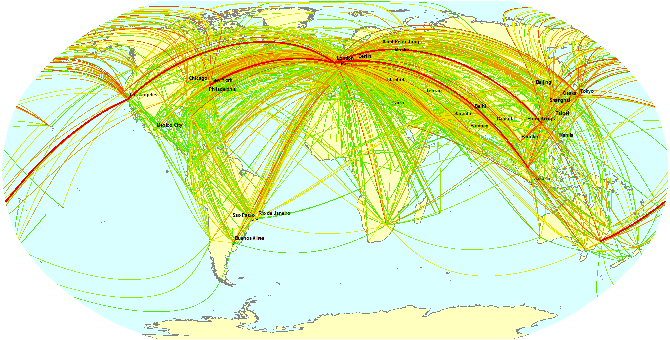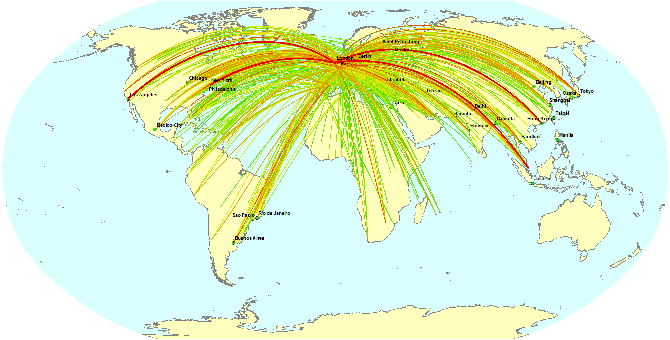Low ambitions at ICAO
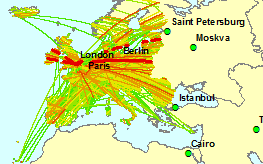 The upcoming 38th ICAO Assembly is likely to agree a narrow scope for any regional carbon pricing of emissions from international aviation. The draft resolution on the issue proposes to limit any such regulation to national airspace of participating countries till a global regime is in place (i.e. by 2020, or longer). This would mean only circa 20% coverage of emissions from extra-European flights, as shown. This may be further limited by exempting flights to and from many developing countries. Together with the other low-ambition elements, the outcome of over 15 years of discussions may be bizarre:
The upcoming 38th ICAO Assembly is likely to agree a narrow scope for any regional carbon pricing of emissions from international aviation. The draft resolution on the issue proposes to limit any such regulation to national airspace of participating countries till a global regime is in place (i.e. by 2020, or longer). This would mean only circa 20% coverage of emissions from extra-European flights, as shown. This may be further limited by exempting flights to and from many developing countries. Together with the other low-ambition elements, the outcome of over 15 years of discussions may be bizarre:
practically no emission reductions by 2020, with little afterwards, if any, and without any contributions to climate finance. All these from passengers that can afford to fly internationally and also benefit from the tax-exempt status of fuels used for such flights.
1: Global problem needs a global solution
Consider CO2 emissions footprint of international aviation
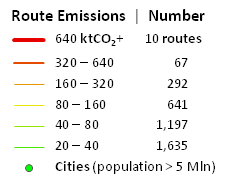
The map illustrates the scale and complexity of international aviation: 200 countries, more than 500 airlines, few thousand aircraft operators, and more than 24 thousand of routes (subset shown). As expected carbon footprint of international aviation is largest on routes to/from certain high-income countries, primarily in North. This includes the United Kingdom, as 8 out of 10 routes with the greatest carbon footprint originate or end at the London Heathrow airport (as shown; see the map's legend, on the left, for emissions per route and number of various routes).
Map details: The map shows emissions from scheduled international flights for 2012, by city pairs (routes). It shows 3,800 main routes out of circa 24,000 international routes.
The routes shown contributed majority of the emissions (nearly 80% of the total for all scheduled international flights; non-scheduled flights are not included).
Map at high resolution (print quality) is available.
The ICAO outcome may mean more talks and cut-down version of the EU scheme till 2020 ...
A quick look at emission coverage of different options for a Market-Based Measure (MBM) for international aviation in the table below illustrates choices. The goal should be option 1 (global MBM with 100% emissions coverage), but the likely outcome till 2020 may be option 3 or 3a.
|
Option |
MBM description |
Coverage, approx. % |
|
1 |
Global MBM (decision to develop is proposed) |
100% |
|
1a |
Global MBM, with 1% de-minims activity threshold, exempting routes to/from countries |
60% |
|
2 |
European ETS, applicable to both departing & arriving flights in EEA countries (currently suspended for extra-EEA flights) |
50% |
|
2b |
European ETS, for departing flights only |
30% |
|
3 |
European ETS, national airspace (and all emissions for intra-EEA flights) |
20% |
|
3a |
European ETS, national airspace, and 1% de-minimis exemption for routes to/from developing countries |
15% |
The maps of routes and emissions covered by the regional options 2 and 3 are shown below.
2: Regional approach (based on departing and/or arriving flights)
Map at high resolution (print quality)
The application of that approach has been suspended for extra-European flights in 2012 for a period of one year to allow the ICAO more time to agree global approach.
3: National airspace approach
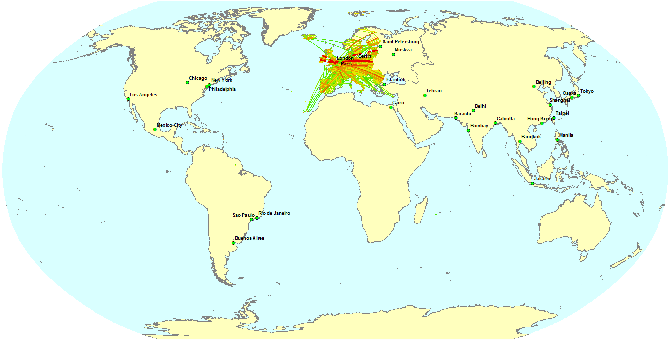
Map at high resolution (print quality)
This approach is severely limiting the amount of emissions from international aviation subject to carbon price, etc., given that majority of emissions on extra European flights take place outside of the countries' national airspace (estimated by us as circa 80%).
How to agree the global approach needed?
The major obstacle in the MBM negotiations is the political need to address national circumstances of various countries, including China, India, but also the US. Furthermore, various poor countries could be unfairly affected through a uniform MBM, notably many small islands developing states and least developed countries as they depend much more than others on international transport for trade and tourism (as reported by us).
There are ways of dealing with all these concerns, for instance through a universal levy on fuel uplifted for international flights charged at the departure country, as it would account for all emissions from international flights while also generating climate finance. To overcome concerns about disproportional impacts on some countries, low-income countries could retain the revenues generated as rebates, high-income countries would contribute 80-90% of the revenues to international climate finance, and countries between these two categories would contribute varying proportions. Such global approach could also be established through an ICAO decision, rather than requiring a new convention or protocol that would take years to develop and enter into force.
Leadership and openness for such ideas is needed if passengers flying internationally are to fairly contribute to action on climate change!
For a detailed proposal, negotiators could contact Dr Andre Stochniol.
